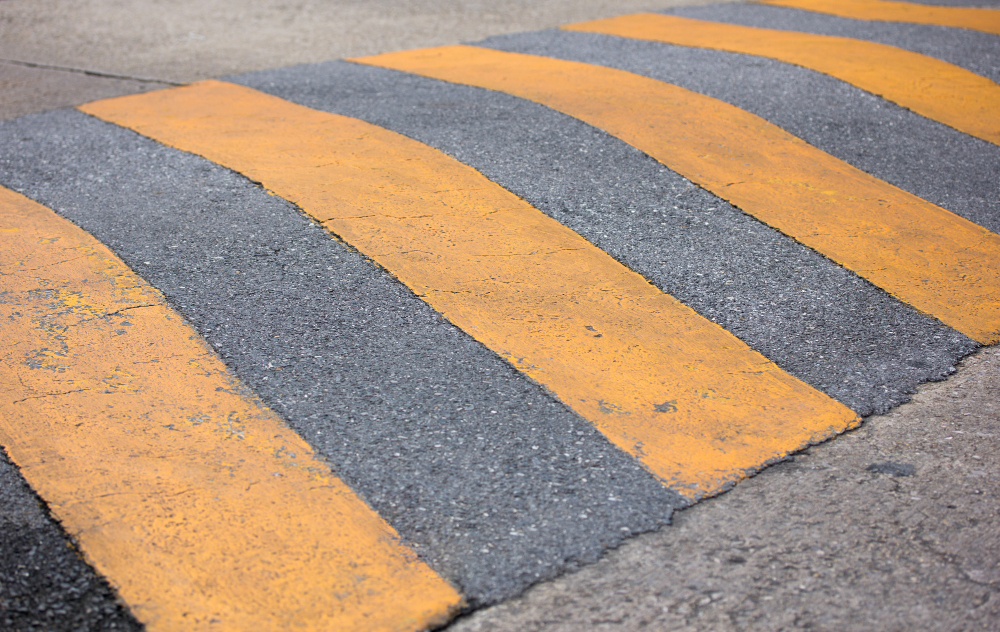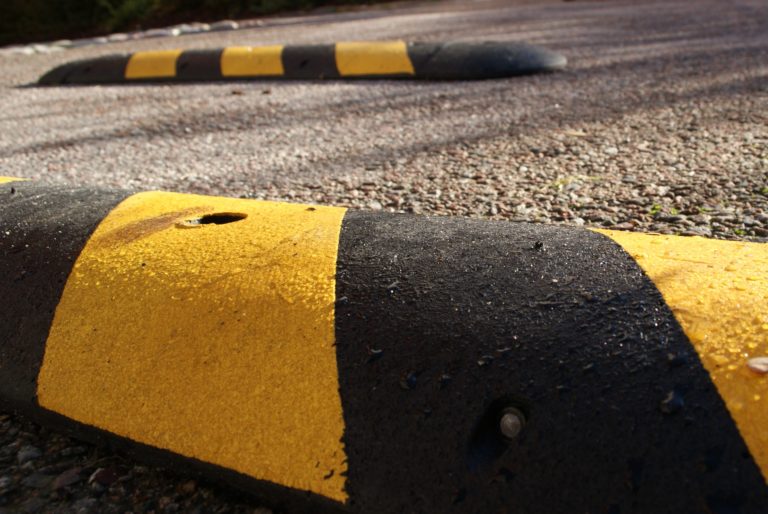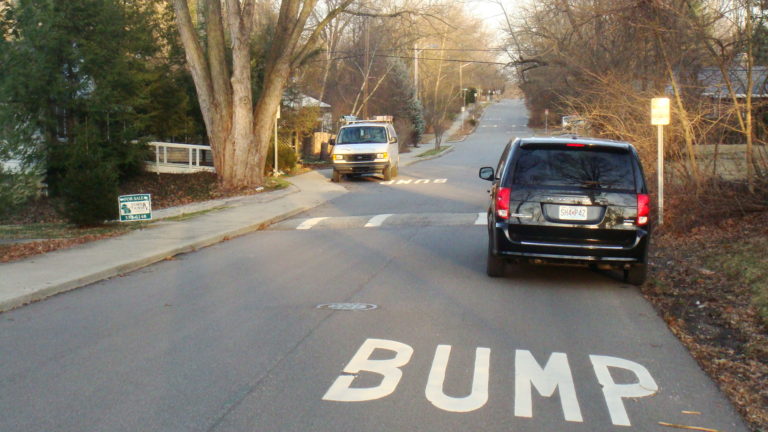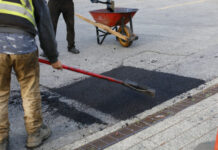Road safety is a paramount concern for communities and municipalities, and one effective solution for controlling vehicular speed and ensuring safe driving conditions is the strategic installation of asphalt speed bumps. These traffic-calming measures play a crucial role in reducing speeds, preventing accidents, and enhancing overall safety on roads. In this comprehensive guide, we delve into the various ways in which road safety is enhanced with asphalt speed bumps, shedding light on their functions, installation process, and the expertise offered by Commonwealth Paving. Located at 136 Outerloop, Louisville, Kentucky 40214, and reachable at +1 502 459 7283, Commonwealth Paving stands as a trusted authority in road construction and infrastructure, emphasizing safety through the strategic use of asphalt speed bumps.
- Controlling Vehicle Speeds:
Asphalt speed bumps serve as effective tools for controlling vehicle speeds on roads, particularly in areas where speed limits need to be enforced. Commonwealth Paving strategically installs these bumps to create a physical deterrent, encouraging drivers to slow down to navigate the raised surface. By controlling speeds, the risk of accidents, especially in residential areas, school zones, and commercial districts, is significantly reduced.
- Preventing Reckless Driving:
Reckless driving poses a serious threat to road safety, leading to accidents, injuries, and property damage. Asphalt speed bumps act as a deterrent to reckless driving behaviors by forcing drivers to reduce their speeds. Commonwealth Paving strategically places speed bumps in areas where reckless driving is a concern, creating a safer environment for both motorists and pedestrians.
- Enhancing Pedestrian Safety:
Pedestrian safety is a top priority in urban planning and road design. Asphalt speed bumps contribute to pedestrian safety by slowing down vehicles in areas with high foot traffic. Crosswalks, school zones, and pedestrian-heavy areas benefit from the installation of speed bumps, ensuring that drivers approach these zones with heightened caution. Commonwealth Paving’s expertise in strategic placement enhances pedestrian safety measures.
- Minimizing Traffic Accidents:
Speed is a significant factor in many traffic accidents. Asphalt speed bumps play a pivotal role in minimizing accidents by compelling drivers to reduce their speeds. The presence of speed bumps helps to create a safer road environment, reducing the likelihood of rear-end collisions, side-swipes, and other accidents that can result from excessive speeds. Commonwealth Paving’s commitment to safety includes the strategic installation of speed bumps to address specific accident-prone areas.

- Protecting Vulnerable Road Users:
Vulnerable road users, including pedestrians, cyclists, and motorcyclists, benefit from the protective measures provided by asphalt speed bumps. These traffic-calming devices contribute to a safer road environment for everyone, especially those with less protection in the event of an accident. Commonwealth Paving prioritizes the protection of vulnerable road users through the strategic placement of speed bumps in areas where their safety is a particular concern.
- Designing Effective Traffic Calming Solutions:
Effective traffic calming solutions are essential for maintaining order and safety on roads. Commonwealth Paving collaborates with municipalities and communities to design and implement comprehensive traffic calming measures, including the strategic use of asphalt speed bumps. The goal is to create road designs that encourage responsible driving behaviors and enhance overall safety for all road users.
- Improving Compliance with Speed Limits:
Asphalt speed bumps are instrumental in improving compliance with posted speed limits. In areas where drivers may be tempted to exceed speed restrictions, the presence of speed bumps acts as a visual and physical reminder to adhere to the posted limits. Commonwealth Paving strategically installs speed bumps to align with speed regulations, contributing to improved compliance and safer road conditions.
- Enhancing Neighborhood Safety:
Residential neighborhoods often face challenges related to speeding vehicles, posing risks to residents and property. Asphalt speed bumps are effective tools for enhancing neighborhood safety by curbing speeding and creating a safer environment for both residents and visitors. Commonwealth Paving collaborates with communities to identify areas where speed bumps can be strategically placed for maximum impact on neighborhood safety.
- Ensuring Consistent Traffic Flow:
While speed bumps are designed to slow down traffic, Commonwealth Paving ensures that their strategic placement considers the need for consistent traffic flow. Properly designed and spaced speed bumps allow for a controlled reduction in speed without causing unnecessary congestion or disruptions to the overall traffic pattern. This approach ensures a balance between safety and traffic efficiency.
- Customization for Specific Road Conditions:
Road conditions vary, and Commonwealth Paving recognizes the importance of customization in addressing specific safety concerns. The company works closely with communities and municipalities to assess road conditions, traffic patterns, and safety needs. Customized solutions, including the strategic use of asphalt speed bumps, are then implemented to address specific challenges and enhance safety on a case-by-case basis.
- Complementing Other Traffic Management Measures:
Asphalt speed bumps are one component of a comprehensive traffic management strategy. Commonwealth Paving ensures that the installation of speed bumps complements other measures, such as signage, road markings, and signalization. This integrated approach maximizes the effectiveness of traffic management efforts, creating a harmonized and well-coordinated system for safer roads.
- Minimizing Noise and Air Pollution:
Reducing vehicle speeds with asphalt speed bumps contributes to minimizing noise and air pollution. Slower-moving vehicles produce less noise, creating a quieter and more pleasant environment for residents and businesses along roadways. Additionally, lower speeds result in reduced emissions, contributing to improved air quality. Commonwealth Paving’s commitment to sustainable and community-friendly road solutions includes considerations for noise and air pollution reduction.
- Durability and Longevity of Asphalt Speed Bumps:
The durability and longevity of asphalt speed bumps are crucial factors in maintaining their effectiveness. Commonwealth Paving prioritizes the use of high-quality materials and precise installation techniques to ensure that speed bumps remain resilient to weather conditions, constant traffic, and the impact of vehicles. This commitment to durability extends the lifespan of speed bumps, providing sustained safety benefits.
- Nighttime Visibility and Safety:
Visibility is critical for the effectiveness of traffic-calming measures, especially during nighttime hours. Commonwealth Paving incorporates reflective elements in the design of asphalt speed bumps to enhance visibility in low-light conditions. This attention to nighttime safety contributes to the overall effectiveness of speed bumps in reducing speeds and preventing accidents.
- Community Engagement and Education:
Community engagement and education are integral components of Commonwealth Paving’s approach to road safety. The company collaborates with communities to raise awareness about the importance of responsible driving and the role of asphalt speed bumps in enhancing safety. Educational initiatives empower residents and drivers with information about the positive impact of speed bumps on road safety.
Enhancing road safety with asphalt speed bumps is a multifaceted and strategic endeavor that requires careful planning, expertise, and a commitment to the well-being of road users. Commonwealth Paving, located at 136 Outerloop, Louisville, Kentucky 40214, and reachable at +1 502 459 7283, stands as a reliable partner in road construction and infrastructure, offering solutions that prioritize safety through the strategic use of asphalt speed bumps.
By addressing specific safety concerns, collaborating with communities, and implementing customized traffic management measures, Commonwealth Paving contributes to creating safer roads for everyone. Property owners, municipalities, and communities seeking to enhance road safety can trust Commonwealth Paving for expert guidance and comprehensive solutions that prioritize safety as a fundamental aspect of road design and construction.
Tips for Optimal Placement of Speed Bumps for Asphalt: A Guide by Commonwealth Paving
Optimal placement of speed bumps for asphalt is a critical aspect of effective traffic management and road safety. Well-placed speed bumps can help control vehicle speeds, enhance pedestrian safety, and minimize the risk of accidents. In this comprehensive guide, we explore valuable tips for the optimal placement of speed bumps for asphalt, shedding light on considerations, strategic placement techniques, and the expertise offered by Commonwealth Paving. Located at 136 Outerloop, Louisville, Kentucky 40214, and reachable at +1 502 459 7283, Commonwealth Paving is a trusted authority in road construction, committed to creating safer road environments through the strategic use of speed bumps.
- Conduct a Traffic Analysis:
Before determining the placement of speed bumps, it’s essential to conduct a thorough traffic analysis of the target area. Commonwealth Paving recommends assessing traffic patterns, average speeds, and any existing safety concerns. Traffic analysis provides valuable data to identify areas where speed bumps can be most effective in addressing specific safety issues.
- Identify High-Risk Zones:
Identifying high-risk zones is a key step in optimal speed bump placement. Commonwealth Paving collaborates with communities and municipalities to pinpoint areas where speeding is prevalent, accidents are frequent, or pedestrian safety is a concern. High-risk zones may include residential areas, school zones, near pedestrian crossings, or areas with a history of traffic incidents.
- Collaborate with Local Authorities:
Effective placement of speed bumps requires collaboration with local authorities and adherence to regulations. Commonwealth Paving recommends working closely with relevant traffic authorities to ensure that proposed speed bump placements align with local regulations and guidelines. Local authorities can provide insights into specific requirements and assist in obtaining necessary approvals.
- Consider Road Geometry:
The geometry of the road plays a crucial role in determining where speed bumps should be placed. Commonwealth Paving evaluates factors such as road curvature, sightlines, and elevation changes. Speed bumps should be strategically placed to account for these road characteristics, ensuring that drivers have sufficient visibility and reaction time to navigate the bumps safely.

- Prioritize Pedestrian Crossings:
Pedestrian safety is a top priority in road design, and speed bumps play a significant role in enhancing safety near pedestrian crossings. Commonwealth Paving recommends prioritizing the placement of speed bumps in proximity to crosswalks and pedestrian-heavy areas. This strategic placement ensures that drivers approach pedestrian crossings at controlled speeds, minimizing the risk of accidents.
- Evaluate School Zones:
School zones are areas where speed bumps can make a significant impact on road safety. Commonwealth Paving conducts evaluations of school zones, taking into account school hours, student commuting patterns, and potential risks associated with high-speed traffic. Speed bumps placed strategically in school zones contribute to a safer environment for students and pedestrians.
- Assess Residential Streets:
Residential streets often face challenges related to speeding vehicles. Commonwealth Paving assesses residential areas to identify where speed bumps can be optimally placed to deter speeding and enhance the safety of residents. Strategic placement on residential streets contributes to a calmer and more secure living environment.
- Ensure Adequate Signage:
Proper signage is essential for informing drivers about the presence of speed bumps. Commonwealth Paving emphasizes the importance of installing clear and visible signage in advance of speed bump locations. Adequate signage ensures that drivers are aware of upcoming speed bumps, allowing them to adjust their speeds accordingly and reducing the risk of abrupt stops.
- Use Speed Bumps as Traffic Calming Measures:
Speed bumps are effective traffic calming measures, and Commonwealth Paving recommends using them strategically in areas where overall traffic calming is desired. Placing speed bumps at regular intervals can create a controlled and uniform flow of traffic, discouraging excessive speeds and promoting a safer road environment.
- Align with Emergency Access Points:
Strategic placement of speed bumps considers emergency access points. Commonwealth Paving ensures that speed bumps are aligned to allow unimpeded access for emergency vehicles. This alignment prevents potential delays during emergencies, striking a balance between traffic calming and the need for swift emergency response.
- Consider Road Width:
The width of the road influences the placement of speed bumps. Commonwealth Paving takes road width into consideration, ensuring that speed bumps are positioned to cover the entire width effectively. Proper placement on wide roads prevents drivers from maneuvering around the speed bumps, maximizing their traffic calming impact.
- Implement Speed Cushions on Arterial Roads:
On arterial roads where maintaining traffic flow is crucial, Commonwealth Paving recommends the use of speed cushions. Speed cushions are wider speed bumps with gaps that accommodate the wider wheelbase of emergency vehicles and buses. These cushions effectively control speeds while allowing larger vehicles to navigate them more comfortably.
- Customize Placement for Specific Conditions:
Every road has unique conditions that influence the placement of speed bumps. Commonwealth Paving customizes placement strategies based on specific road conditions, including factors such as curves, intersections, and parking areas. Customization ensures that speed bumps are strategically positioned to address the specific challenges of each road.
- Optimize Spacing Between Speed Bumps:
The spacing between speed bumps is crucial for maintaining a controlled traffic flow. Commonwealth Paving optimizes the spacing between speed bumps to strike a balance between traffic calming and preventing unnecessary congestion. Properly spaced speed bumps contribute to a smoother driving experience while effectively controlling speeds.
- Monitor and Adjust Placement as Needed:
Road conditions and traffic patterns may change over time, necessitating periodic monitoring and adjustments to speed bump placements. Commonwealth Paving emphasizes the importance of ongoing evaluation to ensure that speed bumps continue to address evolving safety concerns. Monitoring allows for adjustments based on the effectiveness of existing placements and emerging traffic patterns.
Optimal placement of speed bumps for asphalt is a nuanced process that requires a thorough understanding of traffic dynamics, road geometry, and safety priorities. Commonwealth Paving, located at 136 Outerloop, Louisville, Kentucky 40214, and reachable at +1 502 459 7283, stands as a reliable partner in road construction and infrastructure, offering expertise in the strategic placement of speed bumps for enhanced road safety.
By conducting traffic analyses, collaborating with local authorities, and customizing placement strategies, Commonwealth Paving contributes to the creation of safer road environments for communities and municipalities. Property owners, municipalities, and communities seeking to optimize the placement of speed bumps can trust Commonwealth Paving for expert guidance and comprehensive solutions that prioritize safety as a fundamental aspect of road design and construction.
Choosing and Installing the Right Speed Bumps for Asphalt: A Comprehensive Guide by Commonwealth Paving
Selecting and installing the right speed bumps for asphalt is a crucial step in enhancing road safety and controlling vehicle speeds. Whether in residential areas, school zones, or commercial districts, the strategic use of speed bumps contributes to a safer and more orderly traffic environment. In this comprehensive guide, we delve into the considerations for choosing the right speed bumps and the essential steps for their proper installation, with insights provided by Commonwealth Paving. Located at 136 Outerloop, Louisville, Kentucky 40214, and reachable at +1 502 459 7283, Commonwealth Paving is a trusted authority in road construction, committed to creating safer road environments through the strategic use of speed bumps.
- Assessing Traffic Conditions:
Choosing the right speed bumps begins with a thorough assessment of traffic conditions in the target area. Commonwealth Paving recommends conducting a comprehensive traffic analysis to understand average speeds, traffic volumes, and potential safety concerns. This assessment serves as the foundation for selecting speed bumps that address specific challenges and contribute to a safer road environment.
- Identifying the Purpose:
Different types of speed bumps serve varying purposes, and Commonwealth Paving emphasizes the importance of identifying the specific purpose for installing speed bumps. Whether the goal is to control speeds in a residential neighborhood, enhance safety near pedestrian crossings, or address speeding issues in school zones, understanding the purpose guides the selection process.
- Types of Speed Bumps:
There are several types of speed bumps designed to suit different purposes and traffic conditions. Commonwealth Paving provides insights into common types, including:
- Traditional Speed Bumps: These are raised bumps that extend across the width of the road. They are effective in controlling speeds but may cause discomfort for drivers.
- Speed Humps: Similar to traditional speed bumps but longer, speed humps provide a more gradual rise and fall. They are effective for controlling speeds without causing abrupt stops.
- Speed Cushions: These are wider speed bumps with gaps to accommodate the wider wheelbase of emergency vehicles. Speed cushions are suitable for arterial roads where maintaining traffic flow is essential.
- Rubber Speed Bumps: Made from durable rubber materials, these speed bumps are effective in controlling speeds and are often used in parking lots and private roads.
- Asphalt Speed Bumps: Constructed from asphalt, these speed bumps seamlessly blend with the road surface and are durable for long-term use.
Choosing the right type of speed bump depends on the intended purpose, road characteristics, and the preferences of the community or municipality.
- Considering Traffic Flow:
Maintaining a consistent traffic flow is crucial when selecting speed bumps. Commonwealth Paving recommends considering the road’s function and whether it serves as an arterial road, a residential street, or a commercial district. Properly chosen and strategically placed speed bumps should control speeds without causing unnecessary congestion or disruptions to the overall traffic pattern.

- Customizing for Road Characteristics:
Each road has unique characteristics, and the chosen speed bumps should be customized to address specific road conditions. Commonwealth Paving takes into account factors such as road curvature, sightlines, intersections, and road width when customizing speed bump solutions. This customization ensures that speed bumps are seamlessly integrated into the road design.
- Prioritizing Pedestrian Safety:
Pedestrian safety is a top priority, and Commonwealth Paving recommends choosing speed bumps that enhance safety near pedestrian crossings and walkways. The selected speed bumps should encourage drivers to reduce speeds in these areas, creating a safer environment for pedestrians.
- Balancing Comfort and Effectiveness:
While the primary goal of speed bumps is to control speeds, it’s essential to strike a balance between effectiveness and driver comfort. Commonwealth Paving considers the type of speed bump that achieves the desired speed reduction without causing discomfort or potential damage to vehicles. This balance ensures that speed bumps effectively serve their purpose while maintaining a positive driving experience.
- Evaluating Maintenance Requirements:
The chosen speed bumps should have minimal maintenance requirements to ensure long-term effectiveness. Commonwealth Paving recommends selecting speed bumps constructed from durable materials, such as asphalt or high-quality rubber, that can withstand the impact of weather, traffic, and regular wear and tear. Evaluating maintenance needs helps in planning for ongoing care and ensures the longevity of the speed bump solution.
- Reflective Markings for Visibility:
Visibility is crucial for the effectiveness of speed bumps, especially during nighttime hours or adverse weather conditions. Commonwealth Paving recommends the use of reflective markings on speed bumps to enhance visibility. Reflective elements ensure that drivers can easily identify the presence of speed bumps, contributing to safer driving conditions.
- Compliance with Local Regulations:
Before finalizing the selection of speed bumps, Commonwealth Paving stresses the importance of compliance with local regulations and guidelines. Local authorities may have specific requirements regarding the types, dimensions, and placement of speed bumps. Ensuring compliance helps avoid potential issues and ensures that the selected speed bumps align with the established standards.
- Collaborating with Local Authorities:
Effective collaboration with local authorities is essential throughout the process of choosing and installing speed bumps. Commonwealth Paving emphasizes the need for open communication with relevant traffic authorities to obtain necessary approvals, discuss road safety plans, and address any concerns or recommendations they may have.
- Installation Expertise:
Once the right speed bumps are chosen, proper installation is critical for their effectiveness and longevity. Commonwealth Paving brings expertise in the installation process, ensuring that speed bumps are anchored securely, aligned correctly, and integrated seamlessly with the road surface. Professional installation minimizes the risk of issues such as shifting, misalignment, or premature wear.
- Strategic Placement for Maximum Impact:
Strategic placement of speed bumps is essential to achieve maximum impact on controlling speeds and enhancing road safety. Commonwealth Paving conducts site assessments to identify optimal locations based on traffic patterns, safety concerns, and the intended purpose of the speed bumps. Strategic placement ensures that speed bumps contribute effectively to the desired outcomes.
- Prioritizing High-Risk Areas:
High-risk areas, such as school zones, residential streets, or areas with a history of accidents, should be prioritized when installing speed bumps. Commonwealth Paving works with communities to identify and prioritize areas where the installation of speed bumps will have the most significant impact on enhancing road safety.
- Ongoing Evaluation and Adjustments:
After installation, ongoing evaluation is crucial to ensure that the chosen speed bumps continue to address safety concerns effectively. Commonwealth Paving recommends periodic assessments to monitor the performance of speed bumps and make any necessary adjustments based on changing traffic conditions, road usage, or evolving safety priorities.
Choosing and installing the right speed bumps for asphalt is a comprehensive process that requires careful consideration of various factors, including traffic conditions, road characteristics, and safety priorities. Commonwealth Paving, located at 136 Outerloop, Louisville, Kentucky 40214, and reachable at +1 502 459 7283, stands as a reliable partner in road construction and infrastructure, offering expertise in the strategic selection and installation of speed bumps.
By customizing solutions, prioritizing safety, and collaborating with local authorities, Commonwealth Paving contributes to the creation of safer road environments for communities and municipalities. Property owners, municipalities, and communities seeking to enhance road safety through the strategic use of speed bumps can trust Commonwealth Paving for expert guidance and comprehensive solutions that prioritize safety as a fundamental aspect of road design and construction.
Address
Commonwealth Paving, 136 Outerloop, Louisville, Kentucky 40214
Phone: 502-459-7283, Fax: 502-456-2678
Opening Hours
| Monday | 8:00 a.m. – 5:00 p.m. |
| Tuesday | 8:00 a.m. – 5:00 p.m. |
| Wednesday | 8:00 a.m. – 5:00 p.m. |
| Thursday | 8:00 a.m. – 5:00 p.m. |
| Friday | 8:00 a.m. – 5:00 p.m. |
| Saturday | Closed |
| Sunday | Closed |






